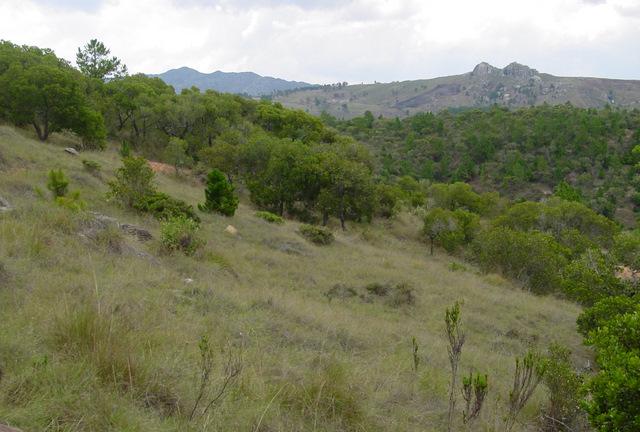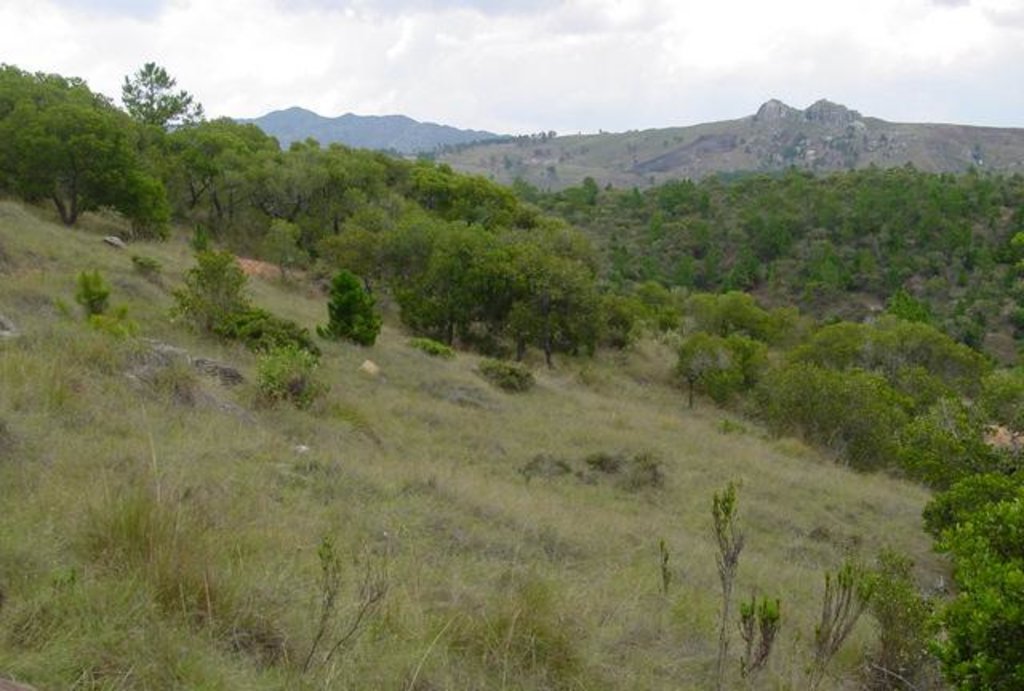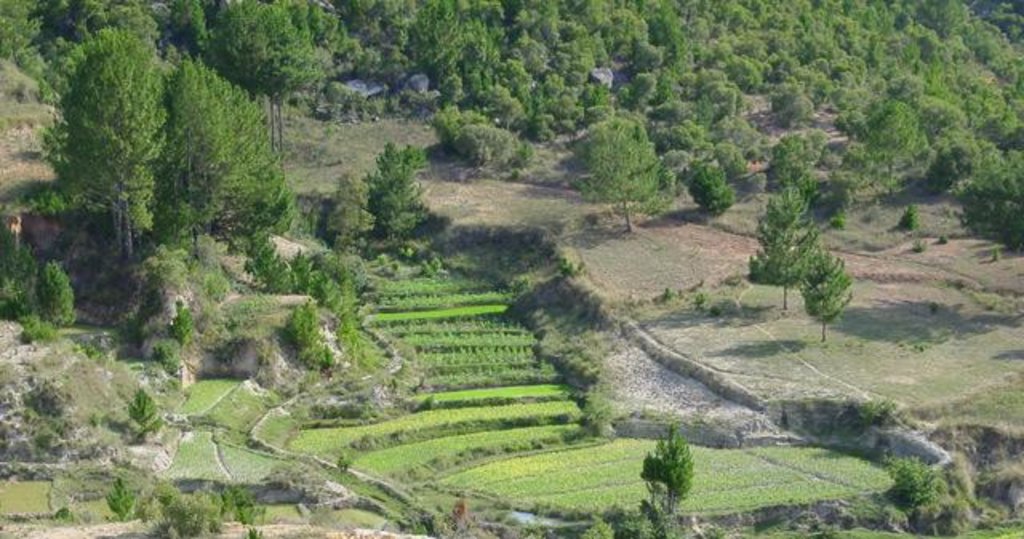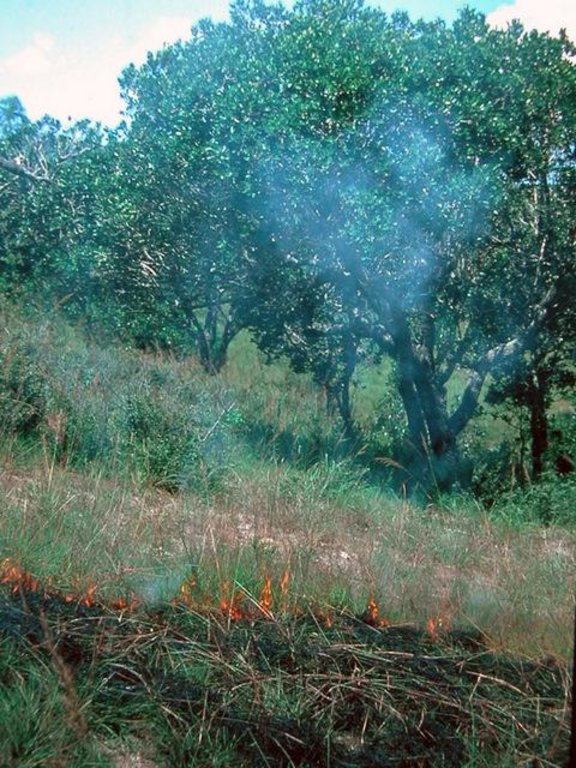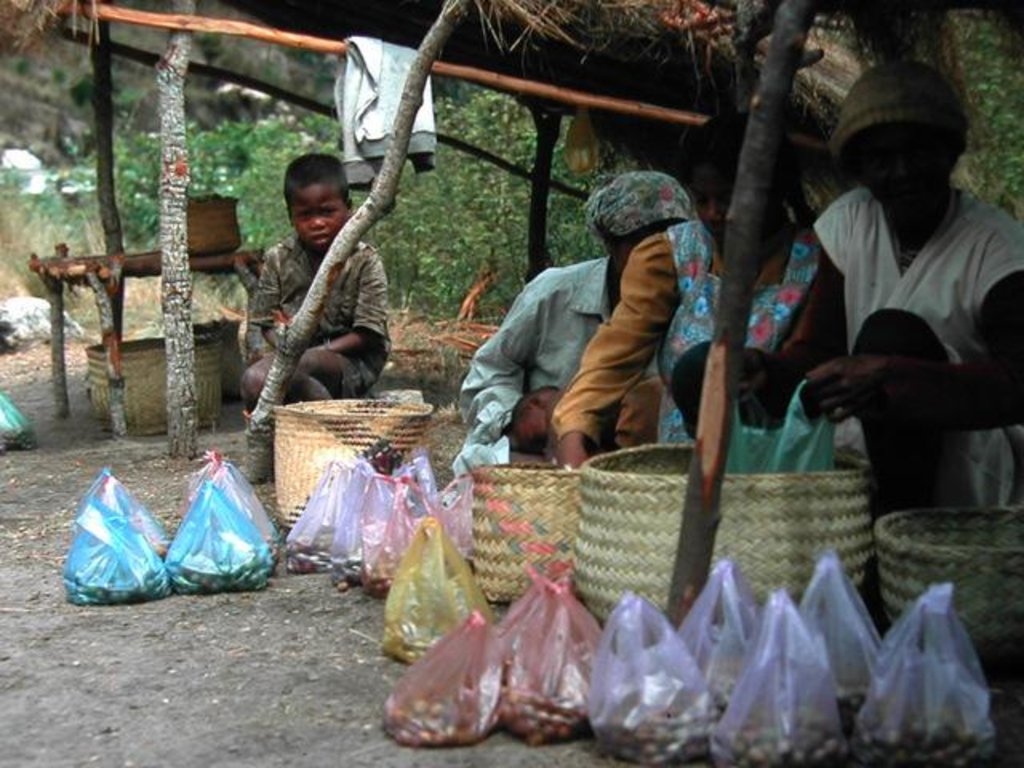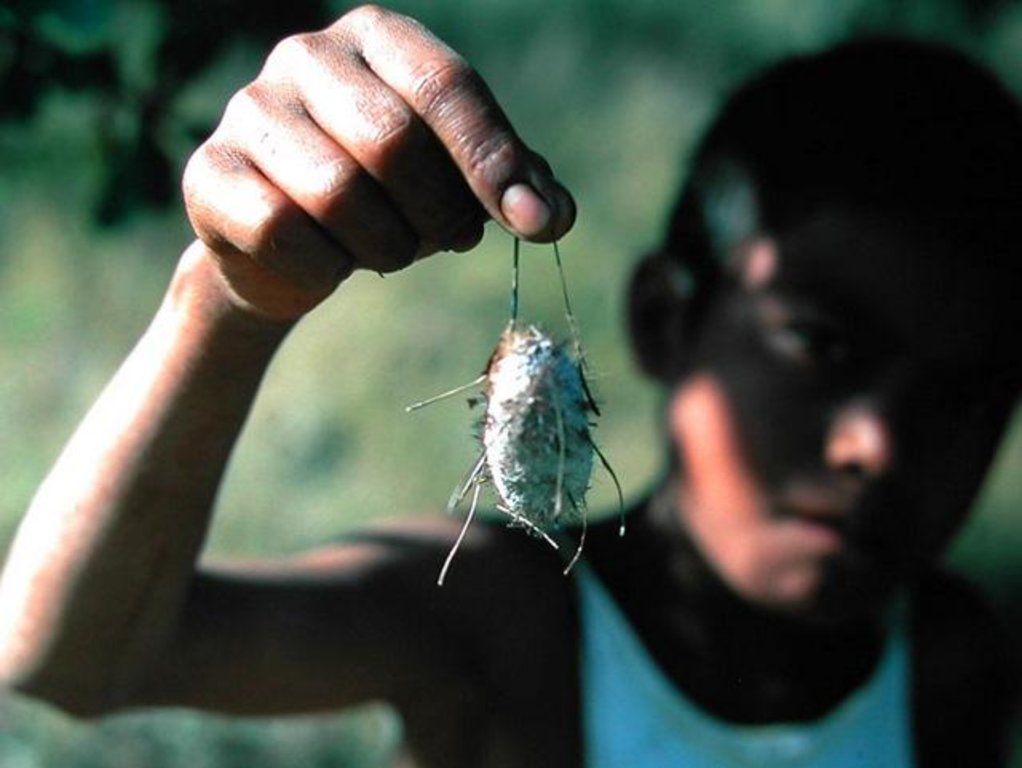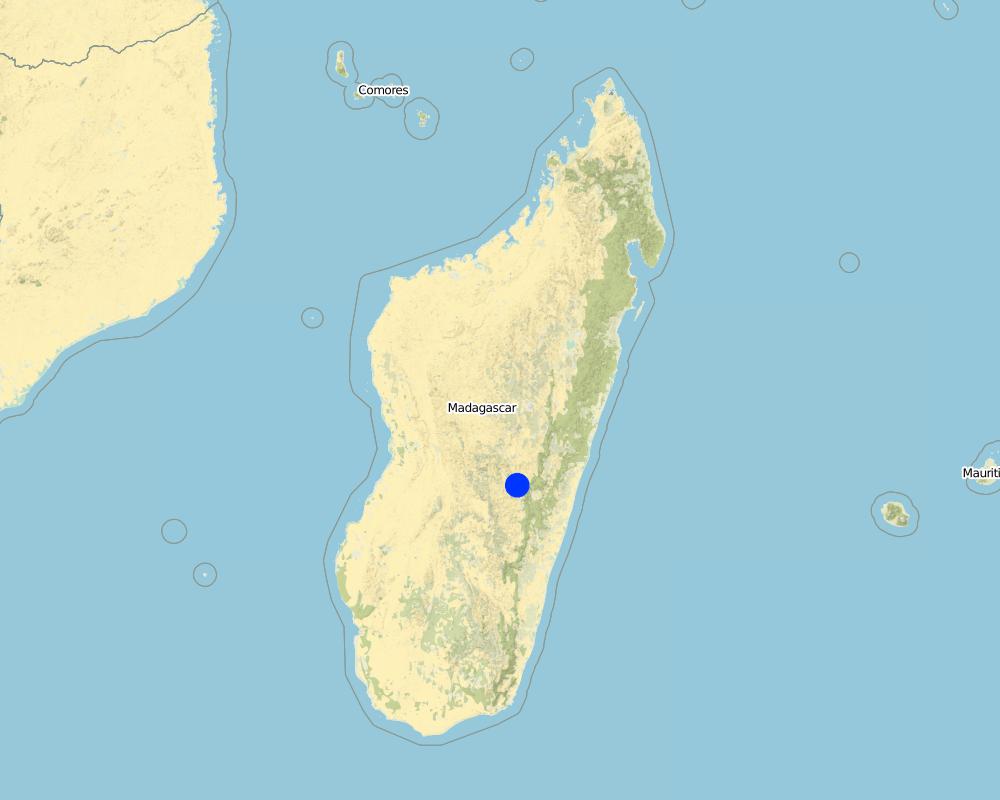Indigenous Management of Tapia Woodlands [มาดากัสการ์]
- ผู้สร้างสรรค์:
- การอัพเดท:
- ผู้รวบรวม: Unknown User
- ผู้เรียบเรียง: –
- ผู้ตรวจสอบ: David Streiff, Fabian Ottiger, Alexandra Gavilano
technologies_1359 - มาดากัสการ์
ดูส่วนย่อย
ขยายทั้งหมด ย่อทั้งหมด1. ข้อมูลทั่วไป
1.2 รายละเอียดที่ติดต่อได้ของผู้รวบรวมและองค์กรที่เกี่ยวข้องในการประเมินและการจัดเตรียมทำเอกสารของเทคโนโลยี
วิทยากรหลัก
ผู้เชี่ยวชาญ SLM:
Kull Christian
School of Geography and Environmental Science, Monash University
ออสเตรเลีย
ชื่อขององค์กรซึ่งอำนวยความสะดวกในการทำเอกสารหรือการประเมินเทคโนโลยี (ถ้าเกี่ยวข้อง)
School of Geography and Environmental Science, Monash University - ออสเตรเลีย1.3 เงื่อนไขการใช้ข้อมูลที่ได้บันทึกผ่านทาง WOCAT
ผู้รวบรวมและวิทยากรหลักยอมรับเงื่อนไขเกี่ยวกับการใช้ข้อมูลที่ถูกบันทึกผ่านทาง WOCAT:
ใช่
2. การอธิบายลักษณะของเทคโนโลยี SLM
2.1 การอธิบายแบบสั้น ๆ ของเทคโนโลยี
คำจำกัดความของเทคโนโลยี:
For centuries, the population of the highlands of central and south-western Madagascar has sustainably managed and conserved the local tapia woodlands.
2.2 การอธิบายแบบละเอียดของเทคโนโลยี
คำอธิบาย:
These woodlands play an important economic role as a source of non-timber forest products (NTFP) such as wild silk, fruit, mushrooms, edible insects, and herbal medicines. Tapia trees (Uapaca bojeri) comprise up to 90% of all trees in these woodlands, bear an edible fruit, and their leaves nourish an endemic silkworm (landibe). Landibe silk is used to produce ritual burial shrouds throughout the highlands. Trading silk products and tapia fruits is a crucial source of cash income for the local communities. The tapia woodlands are maintained by the local villagers through burning and selective cutting. Burning favours the dominance of pyrophytic (fire-tolerant) tapia trees and protects silkworms from parasites. Selective cutting of non-tapia species and pruning of dead branches also favours tapia dominance and perhaps growth. Other common species include the endemic Sarcolaena eriophora and the invasive Pinus patula/khasya. The Tapia woodland is clearly an anthropogenically shaped forest. However, the creation and maintenance of the woodlands should be seen as positive transformation rather than a form of degradation.
Local and state-imposed regulations protect the woodlands from overexploitation. The Forest Service has placed restrictions on forest cutting and burning while allowing for traditional use rights. The collection of forest products is regulated through a type of common-property regime. For example, fuelwood collection is limited to dead trees or fallen branches. It is forbidden to break off large branches to access cocoons. Thanks to these protective regulations, forest boundaries are mostly stable, and woodland density has increased in several cases.
2.3 รูปภาพของเทคโนโลยี
2.5 ประเทศภูมิภาค หรือสถานที่ตั้งที่เทคโนโลยีได้นำไปใช้และได้รับการครอบคลุมโดยการประเมินนี้
ประเทศ:
มาดากัสการ์
ภูมิภาค/รัฐ/จังหวัด:
Col des Tapia
ข้อมูลจำเพาะเพิ่มเติมของสถานที่ตั้ง :
Antsirabe and Ambositra
ระบุการกระจายตัวของเทคโนโลยี:
- กระจายไปอย่างสม่ำเสมอในพื้นที่
If the Technology is evenly spread over an area, specify area covered (in km2):
2600.0
แสดงความคิดเห็น:
Total area covered by the SLM Technology is 2600 km2.
Map
×2.6 วันที่การดำเนินการ
ถ้าไม่รู้ปีที่แน่นอน ให้ระบุวันที่โดยประมาณ:
- มากกว่า 50 ปี (แบบดั้งเดิม)
2.7 คำแนะนำของเทคโนโลยี
ให้ระบุว่าเทคโนโลยีถูกแนะนำเข้ามาอย่างไร:
- เป็นส่วนหนึ่งของระบบแบบดั้งเดิมที่ทำก้นอยู่ (> 50 ปี)
3. การจัดประเภทของเทคโนโลยี SLM
3.1 วัตถุประสงค์หลักของเทคโนโลยี
- อนุรักษ์ระบบนิเวศน์
- สร้างผลกระทบทางด้านเศรษฐกิจที่เป็นประโยชน์
3.2 ประเภทของการใช้ที่ดินในปัจจุบันที่ได้นำเทคโนโลยีไปใช้
Land use mixed within the same land unit:
ใช่
Specify mixed land use (crops/ grazing/ trees):
- ปศุสัตว์ร่วมกับการทำป่าไม้ (Silvo-pastoralism)

ทุ่งหญ้าเลี้ยงสัตว์

ป่า/พื้นที่ทำไม้
- ป่ากึ่งธรรมชาติ / พื้นที่ทำไม้
- Sustainable forest management
(Semi-)natural forests/ woodlands: Specify management type:
- การตัดไม้ที่มีคัดเลือก (Selective felling)
ผลิตภัณฑ์และบริการ:
- ไม้ซุง
- ไม้ที่นำมาทำเป็นเชื้อเพลิง
- ผลไม้และถั่ว
- ผลิตภัณฑ์อื่น ๆ จากป่า
- การแทะเล็มหญ้า / การเก็บกินหญ้า
แสดงความคิดเห็น:
Major land use problems (land users’ perception): Reduction of vegetation cover; Quantity biomass decline
Selective felling of (semi-) natural forests: Yes
Other type of forest: sustainable forest management
Forest products and services: fuelwood, fruits and nuts, other forest products / uses (honey, medical, etc.)
3.5 กลุ่ม SLM ที่ตรงกับเทคโนโลยีนี้
- การจัดการป่าธรรมชาติและกึ่งธรรมชาติ
- การเลี้ยงผึ้ง การเพาะเลี้ยงสัตว์น้ำ สัตว์ปีก ฟาร์มกระต่าย ฟาร์มหนอนไหม
3.6 มาตรการ SLM ที่ประกอบกันเป็นเทคโนโลยี

มาตรการอนุรักษ์ด้วยการจัดการ
- M2: การเปลี่ยนแปลงของการจัดการหรือระดับความเข้มข้น
แสดงความคิดเห็น:
Main measures: management measures
3.7 รูปแบบหลักของการเสื่อมโทรมของที่ดินที่ได้รับการแก้ไขโดยเทคโนโลยี

การเสื่อมโทรมของดินทางด้านชีวภาพ
- Bc (Reduction of vegetation cover): การลดลงของจำนวนพืชที่ปกคลุมดิน
- Bq (Quantity/biomass decline): การลดลงของปริมาณหรือมวลชีวภาพ
แสดงความคิดเห็น:
Main type of degradation addressed: Bc: reduction of vegetation cover, Bq: quantity / biomass decline
3.8 การป้องกัน การลดลง หรือการฟื้นฟูความเสื่อมโทรมของที่ดิน
ระบุเป้าหมายของเทคโนโลยีกับความเสื่อมโทรมของที่ดิน:
- ป้องกันความเสื่อมโทรมของที่ดิน
- ลดความเสื่อมโทรมของดิน
แสดงความคิดเห็น:
Main goals: prevention of land degradation, mitigation / reduction of land degradation
4. ข้อมูลจำเพาะด้านเทคนิค กิจกรรมการนำไปปฏิบัติใช้ ปัจจัยนำเข้า และค่าใช้จ่าย
4.1 แบบแปลนทางเทคนิคของเทคโนโลยี
ข้อมูลจำเพาะด้านเทคนิค (แบบแปลนทางเทคนิคของเทคโนโลยี):
Technical knowledge required for field staff / advisors: (traditional practice)
Technical knowledge required for land users: low (children often harvest fruit; silk cocoon harvest is easy)
Main technical functions: control of raindrop splash, improvement of ground cover, stabilisation of soil (eg by tree roots against land slides), increase in organic matter, increase of biomass (quantity), promotion of vegetation species and varieties (quality, eg palatable fodder), control of fires, spatial arrangement and diversification of land use
Change of land use practices / intensity level: The tapia woodlands are maintained by the local villagers through burning and selective cutting
4.2 ข้อมูลทั่วไปเกี่ยวกับการคำนวณปัจจัยนำเข้าและค่าใช้จ่าย
ระบุสกุลเงินที่ใช้คำนวณค่าใช้จ่าย:
- USD
4.3 กิจกรรมเพื่อการจัดตั้ง
| กิจกรรม | Timing (season) | |
|---|---|---|
| 1. | N |
4.5 การบำรุงรักษาสภาพหรือกิจกรรมที่เกิดขึ้นเป็นประจำ
| กิจกรรม | ช่วงระยะเวลา/ความถี่ | |
|---|---|---|
| 1. | Selective cutting of non-tapia species, especially invasive pines | |
| 2. | Pruning of dead branches | |
| 3. | Controlled burning mainly through understory fires after the rainy season | Jan-May |
| 4. | Collection of non-wood forest products such as fruits, medicinal plants, mushrooms, berries, insects, and hunting of mammals etc | Sept.-Dec |
| 5. | Collection of landibe silkworm twice a year. The cocoons are cooked, spun and woven into silk fabric | Nov-Dec and May-June |
4.6 ค่าใช้จ่ายของปัจจัยนำเข้าและกิจกรรมที่เกิดขึ้นเป็นประจำที่ต้องการการบำรุงรักษา (ต่อปี)
| ปัจจัยนำเข้า | หน่วย | ปริมาณ | ค่าใช้จ่ายต่อหน่วย | ค่าใช้จ่ายทั้งหมดต่อปัจจัยนำเข้า | %ของค่าใช้จ่ายที่ก่อให้เกิดขึ้นโดยผู้ใช้ที่ดิน | |
|---|---|---|---|---|---|---|
| แรงงาน | Labour | ha | 1.0 | 20.0 | 20.0 | 100.0 |
| ค่าใช้จ่ายทั้งหมดของการบำรุงรักษาสภาพเทคโนโลยี | 20.0 | |||||
| Total costs for maintenance of the Technology in USD | 20.0 | |||||
แสดงความคิดเห็น:
Traditional method; no establishment phase and costs.
4.7 ปัจจัยสำคัญที่สุดที่มีผลกระทบต่อค่าใช้จ่าย
ปัจจัยสำคัญที่สุดที่มีผลกระทบต่อค่าใช้จ่ายต่างๆ:
The estimation of costs is difficult - fruit are gathered over a two month period by school children going out for an hour in the early morning each day; the silkworms are collected by individuals (usually experienced collectors) on free days. In some areas, projects exist that run silkworm nurseries, establish firebreaks in the woodlands, grow and plant tapia seedlings, and finance the purchase of silk looms. These projects obviously require much larger budgets.
5. สิ่งแวดล้อมทางธรรมชาติและของมนุษย์
5.1 ภูมิอากาศ
ฝนประจำปี
- < 250 ม.ม.
- 251-500 ม.ม.
- 501-750 ม.ม.
- 751-1,000 ม.ม.
- 1,001-1,500 ม.ม.
- 1,501-2,000 ม.ม.
- 2,001-3,000 ม.ม.
- 3,001-4,000 ม.ม.
- > 4,000 ม.ม.
ข้อมูลจำเพาะ/ความคิดเห็นเรื่องปริมาณน้ำฝน:
7 months of dry season
เขตภูมิอากาศเกษตร
- กึ่งชุ่มชื้น
Thermal climate class: tropics
5.2 สภาพภูมิประเทศ
ค่าเฉลี่ยความลาดชัน:
- ราบเรียบ (0-2%)
- ลาดที่ไม่ชัน (3-5%)
- ปานกลาง (6-10%)
- เป็นลูกคลื่น (11-15%)
- เป็นเนิน (16-30%)
- ชัน (31-60%)
- ชันมาก (>60%)
ธรณีสัณฐาน:
- ที่ราบสูง/ที่ราบ
- สันเขา
- ไหล่เขา
- ไหล่เนินเขา
- ตีนเนิน
- หุบเขา
ระดับความสูง:
- 0-100 เมตร
- 101-500 เมตร
- 501-1,000 เมตร
- 1,001-1,500 เมตร
- 1,501-2,000 เมตร
- 2,001-2,500 เมตร
- 2,501-3,000 เมตร
- 3,001-4,000 เมตร
- > 4,000 เมตร
ความคิดเห็นและข้อมูลจำเพาะเพิ่มเติมเรื่องสภาพภูมิประเทศ:
Slopes on average: hilly (16-30%), steep (31-60%), very steep (>60%)
Altitudinal zones: 500-2000 m a.s.l.
5.3 ดิน
ค่าเฉลี่ยความลึกของดิน:
- ตื้นมาก (0-20 ซ.ม.)
- ตื้น (21-50 ซ.ม.)
- ลึกปานกลาง (51-80 ซ.ม.)
- ลึก (81-120 ซ.ม.)
- ลึกมาก (>120 ซ.ม.)
เนื้อดิน (ดินชั้นบน):
- หยาบ/เบา (ดินทราย)
อินทรียวัตถุในดิน:
- ต่ำ (<1%)
(ถ้ามี) ให้แนบคำอธิบายเรื่องดินแบบเต็มหรือระบุข้อมูลที่มีอยู่ เช่น ชนิดของดิน ค่า pH ของดินหรือความเป็นกรดของดิน ความสามารถในการแลกเปลี่ยนประจุบวก ไนโตรเจน ความเค็ม เป็นต้น:
Soil texture is coarse/light (sandy) (silica-rich soils compared to the main lateritic soils of highland Madagascar)
Soil fertility is low ( mostly nutrient-poor or rocky soils )
Soil drainage/infiltration is good
5.6 ลักษณะของผู้ใช้ที่ดินที่นำเทคโนโลยีไปปฏิบัติใช้
แนวทางการตลาดของระบบการผลิต:
- เพื่อการยังชีพ (หาเลี้ยงตนเอง)
- mixed (subsistence/ commercial)
ระบุลักษณะอื่นๆที่เกี่ยวข้องของผู้ใช้ที่ดิน:
Land users applying the Technology are mainly disadvantaged land users
Difference in the involvement of women and men: Population density: 20-40 persons/ km2 in the central highlands and 10-20 in the western highlands
5.7 Average area of land used by land users applying the Technology
- < 0.5 เฮกตาร์
- 0.5-1 เฮกตาร์
- 1-2 เฮกตาร์
- 2-5 เฮกตาร์
- 5-15 เฮกตาร์
- 15-50 เฮกตาร์
- 50-100 เฮกตาร์
- 100-500 เฮกตาร์
- 500-1,000 เฮกตาร์
- 1,000-10,000 เฮกตาร์
- >10,000 เฮกตาร์
พิจารณาว่าเป็นขนาดเล็ก กลาง หรือขนาดใหญ่ (ซึ่งอ้างอิงถึงบริบทระดับท้องถิ่น):
- ขนาดเล็ก
5.8 กรรมสิทธิ์ในที่ดิน สิทธิในการใช้ที่ดินและสิทธิในการใช้น้ำ
กรรมสิทธิ์ในที่ดิน:
- รัฐ
สิทธิในการใช้ที่ดิน:
- เกี่ยวกับชุมชน (ถูกจัดระเบียบ)
แสดงความคิดเห็น:
Woodlands are officially state-owned, but in practice managed by neighbouring communities (either unofficially, or increasingly through community-based management contracts
6. ผลกระทบและสรุปคำบอกกล่าว
6.1 ผลกระทบในพื้นที่ดำเนินการ (On-site) จากการใช้เทคโนโลยี
ผลกระทบทางด้านเศรษฐกิจและสังคม
การผลิต
การผลิตไม้
แสดงความคิดเห็น/ระบุ:
Stable supply of fuelwood
รายได้และค่าใช้จ่าย
รายได้จากฟาร์ม
แสดงความคิดเห็น/ระบุ:
Through selling silk-fabrics and other NTFP
ผลกระทบทางด้านเศรษฐกิจและสังคมอื่น ๆ
Production of NTFP as important dietary supplements
Provision of medicinal plants
ผลกระทบด้านสังคมวัฒนธรรมอื่น ๆ
ความมั่นคงด้านอาหาร / พึ่งตนเองได้
แสดงความคิดเห็น/ระบุ:
Thorugh the forest products
โอกาสทางวัฒนธรรม
แสดงความคิดเห็น/ระบุ:
Sacred forest
ผลกระทบด้านนิเวศวิทยา
ดิน
สิ่งปกคลุมดิน
การสูญเสียดิน
ความหลากหลายทางชีวภาพของพืชและสัตว์
มวลชีวภาพ/เหนือดินชั้น C
ความหลากหลายทางชีวภาพของพืช
แสดงความคิดเห็น/ระบุ:
Endemic biodiversity
6.3 การเผชิญและความตอบสนองของเทคโนโลยีต่อการเปลี่ยนแปลงสภาพภูมิอากาศที่ค่อยเป็นค่อยไป และสภาพรุนแรงของภูมิอากาศ / ภัยพิบัติ (ที่รับรู้ได้โดยผู้ใช้ที่ดิน)
แสดงความคิดเห็น:
Silk and fruit harvests vary from season to season but drivers are poorly understood (could include precipitation and temperature)
6.4 การวิเคราะห์ค่าใช้จ่ายและผลประโยชน์ที่ได้รับ
ผลประโยชน์ที่ได้รับเปรียบเทียบกับค่าใช้จ่ายในการบำรุงรักษาหรือต้นทุนที่เกิดขึ้นซ้ำอีก เป็นอย่างไร (จากมุมมองของผู้ใช้ที่ดิน)
ผลตอบแทนระยะสั้น:
ด้านบวก
ผลตอบแทนระยะยาว:
ด้านบวก
แสดงความคิดเห็น:
The larger rainy season silk harvest provides crucial cash income during the meagre months before the rice harvest. In 1998 the price of 200 cocoons was between US$ 0.10-0.15. For a basket of Tapia fruits villagers earned between 0.02-0.06 US$/ kg. During
6.5 การปรับตัวของเทคโนโลยี
แสดงความคิดเห็น:
Comments on adoption trend: see Annex 3
6.7 จุดแข็ง / ข้อได้เปรียบ / โอกาสของเทคโนโลยี
| จุดแข็ง / ข้อได้เปรียบ / โอกาสในทัศนคติของผู้รวบรวมหรือวิทยากรหลัก |
|---|
| Thanks to these protective regulations, forest boundaries are mostly stable, and woodland density has increased in several cases |
| La vente des produits en soie et des fruits de Tapia est une source de revenus capitale pour les communautés locales |
6.8 จุดอ่อน / ข้อเสียเปรียบ / ความเสี่ยงของเทคโนโลยีและวิธีการแก้ไข
| จุดอ่อน / ข้อเสียเปรียบ / ความเสี่ยงในทัศนคติของผู้รวบรวมหรือวิทยากรหลัก | มีวิธีการแก้ไขได้อย่างไร |
|---|---|
| Partly individual indiscriminate cutting and/or strong use of fires leads to overuse of the forest resources | needs clear regulations, guidelines and observation of the rules by the local authorities as well as awareness raising about the multiple benefits of the forests. As long as the communities continue to be interested in the forests and its products, they will protect it from destructive cutting. |
| Invasion of exotic tree species such as pine and eucalyptus from private and village woodlots | the forest service has rightly been encouraging communities to cut these trees from the tapia forests without the need for complicated permits. |
| Insecure land use rights | in 1996 a new legislation opened the way to officially decentralize management of state-owned renewable natural resources to adjacent communities, which would aid woodland protection by increasing stakeholder involvement. |
| In some areas, silkworm populations have been very low for decades | recent projects seek to establish silk nurseries and reintroduce the worm |
7. การอ้างอิงและการเชื่อมต่อ
7.2 การอ้างอิงถึงสิ่งตีพิมพ์
หัวข้อ, ผู้เขียน, ปี, หมายเลข ISBN:
Kull CA (2002): The ‘Degraded’ Tapia Woodlands of Highland Madagascar: Rural Economy, Fire Ecology, and Forest Conservation. Journal of Cultural Geography Spring/ Summer 2002.
ลิงก์และโมดูล
ขยายทั้งหมด ย่อทั้งหมดลิงก์
ไม่มีลิงก์
โมดูล
ไม่มีโมดูล


